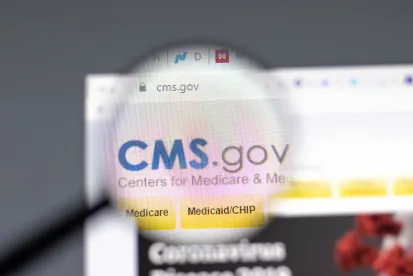On January 30, 2023, the Centers for Medicare & Medicaid Services (“CMS”) released the long-delayed final rule on risk adjustment data validation (“RADV”) audits of Medicare Advantage (“MA”) organizations (the “Final Rule”). CMS promotes the Final Rule as improving program integrity and payment accuracy as well as transparency and certainty. One thing that is certain, CMS can expect further challenges to its RADV audit methodology.
The Final Rule implements the following changes:
-
CMS will extrapolate RADV audit findings beginning with payment year (“PY”) 2018 and will not extrapolate RADV audit findings for PYs 2011 through 2017. This applies to both CMS RADV audits as well as Department of Health and Human Services Office of Inspector General (“OIG”) RADV audits.
-
CMS will not apply a Fee-For-Service (“FFS”) Adjuster in RADV audits.
-
MA organizations will be required to remit improper payments identified during RADV audits in a manner specified by CMS.
Despite its promise of transparency and certainty, CMS
-
Did not adopt any specific sampling or extrapolated audit methodology. Rather, CMS will rely on “any statistically valid method for sampling and extrapolation that is determined to be well-suited to a particular audit.”
-
Shifted its RADV approach to a more targeted, risk-based approach that incorporates unspecified risk factors, although CMS did suggest a focus area would be HCCs that are more likely to be in error based on prior RADV audits.
We analyze below each of the three key components of the Final Rule:
Extrapolation
In confirming its use of extrapolation effective for PY 2018 RADV audits and with an eye towards potential future litigation, CMS defended its use of and its authority to use extrapolation and to retroactively apply extrapolation to past audits based on a number of sources, including case law, statutory and regulatory authority, and historical use.
-
Case Law: CMS argued that “courts have held that sampling and extrapolation are a valid method of calculating improper Medicare payments, so long as statistically valid methods are used. See United States v. Lahey Clinic Hosp., Inc., 399 F.3d 1, 18 n.19 (1st Cir. 2005) (noting that “sampling of similar claims and extrapolation from the sample is a recognized method of proof” for the United States in an affirmative case seeking recovery under a common-law theory). See also Ratanasen v. California Dep’t of Health Servs., 11 F.3d 1467, 1469-71 (9th Cir. 1993) (collecting cases in which sampling and extrapolation have been approved in the Medicaid context, and “join[ing] other circuits in approving the use of sampling and extrapolation as part of audits in connection with Medicare and other similar programs”); Chaves Cnty. Home Health Serv. v. Sullivan, 931 F.2d 914, 917-23 (D.C. Cir. 1991).”
-
Statutory and Regulatory Authority: CMS cited its statutory authority to audit providers and recoup improper payments under the Medicare statute. Likewise CMS cited its fiduciary duty to protect taxpayer dollars from overpayments and its fiduciary responsibility to recover funds due to the Medicare Trust Funds.
-
Historical Use: CMS noted that sampling and extrapolation have been used to calculate improper payments in the Medicare Fee For Service context (Part A and Part B) for decades, with Medicare Administrative Contractors using it since 1972 and CMS formally approving the technique in 1986.
Acknowledging arguments that applying its sampling and extrapolation methodologies to past payment years constitutes retroactive rulemaking in violation of 42 U.S.C. § 1395hh(e)(1)(A), CMS claimed:
-
CMS’s policy does not impose any new requirements on MAOs that could be construed as retroactive because the substantive requirement of proper medical record documentation of all diagnoses submitted for payment remains unchanged, whether CMS calculates audit recoveries on an enrollee-by-enrollee basis or uses a statistically valid sample of enrollees to extrapolate.
-
Even if the methodology was determined to be a retroactive application of policy, it is still necessary to comply with statutory requirements and is in the public interest for CMS to apply extrapolation to past payment years, and, therefore, is authorized by § 1395hh(e)(1)(A).
CMS rationalized its decision not to use extrapolation prior to PY 2018 audits, as follows:
-
Beginning extrapolation for PY 2018 RADV audits represents an appropriate policy because it recognizes CMS’s fiduciary duty to protect taxpayer dollars from overpayments and preserves CMS’s ability to collect on significant (extrapolated) amounts of overpayments made to plans beginning in PY 2018.
-
The approach will allow CMS to focus on conducting future RADV audits as soon as practicable after an MA organization payment year concludes.
-
It is in the best interest of all parties to ensure that the contract-level RADV appeals process is able to successfully process all RADV appeals. By not using an extrapolation methodology prior to PY 2018, CMS expects to better control the total number of active appeals that are submitted in the first few years following the Final Rule, which will alleviate burden on MAOs and CMS
Importantly, the use of extrapolation will not be automatic. CMS is finalizing § 422.311(a)(2) to read “CMS may apply extrapolation to audits for payment year 2018 and subsequent payment years,” rather than “CMS will apply extrapolation” as previously proposed. (emphasis added). According to CMS, there may be unforeseen circumstances in which the statistical validity of the sample is disturbed (such as the need to exclude a large number of cases from the sample due to the loss of medical records in a natural disaster) and extrapolation is no longer possible, despite the initial intent to do so. CMS further provided that there may be other limited instances in which CMS seeks to collect overpayments associated only with enrollees in a given sample, or wishes to perform only a probe sample of RADV reviews without the use of a statistically valid sample and yet will seek to recover any identified, non-extrapolated overpayments. However, CMS stressed that its use of “may” is not intended to signal that it would be a frequent occurrence to not extrapolate in PY 2018 and future audits.
FFS Adjuster
Back in 2012, CMS announced that it would apply a FFS Adjuster to RADV audit findings to account for any effect of erroneous diagnosis codes in the data from Medicare Parts A and B that are used to calibrate the MA risk adjustment model. The FFS Adjuster would calculate a permissible level of payment error (for example, a percentage of the total payments made on an MA contract in a given year) and limit RADV audit recovery to payment errors above that level.
Subsequent to its 2012 announcement, CMS conducted a study on the presence and impact of diagnosis error in FFS claims data, which CMS claims suggested that errors in FFS claims data do not have any systematic effect on the risk scores calculated by the risk adjustment model, and therefore do not have any systematic effect on the payments made to MAOs. Since, based on its study, it appeared that diagnosis error in FFS claims data does not lead to systematic payment error in the MA program, CMS issued a proposed rule in 2018 that would not include a FFS Adjuster in any final RADV payment error methodology.
In finalizing its proposal to not include a FFS Adjuster in its final RADV payment error methodology, CMS seems to rely less on its prior and highly criticized study and more on the D.C. Circuit Court of Appeals decision in UnitedHealthcare Insurance Co. et al. v. Becerra et al., case number 18-5326, which reinstated CMS’s Overpayment Rule for MA organizations. The Overpayment Rule, promulgated in 2014 as part of the Affordable Care Act, requires an MAO to “report and return any overpayment it received no later than 60 days after the date on which it identified it received an overpayment” and defines an overpayment as “identified” when the MAO “has determined, or should have determined through the exercise of reasonable diligence that the MA organization has received an overpayment.” 42 C.F.R. §§ 422.326(d), (c). UnitedHealth challenged the rule on several grounds including that (i) it violated the statutory requirement of actuarial equivalence between payments to MAOs and traditional Medicare expenditures, and (ii) it was arbitrary and capricious because it did not incorporate an adjustment factor similar to the FFS Adjuster included in CMS’s 2012 RADV audit rules. The U.S. District for the District of Columbia agreed with United and vacated the Overpayment Rule.
The Court of Appeals reversed and reinstated the Overpayment Rule. With respect to the actuarial equivalence holding, the Court found that, based on the text of the statutory mandate, the actuarial equivalence requirement in the Medicare Advantage statute applies to the way in which CMS determines payments to MAOs, and has no application to the Overpayment Rule. In particular, nothing in the text of either the actuarial equivalence requirement or the Overpayment Rule explicitly indicates that actuarial equivalence could be “a defense against the obligation to refund any individual, known overpayment.” Further, the Court concluded that, even if the actuarial equivalence requirement were interpreted to disallow an overpayment recovery mechanism that would result in lower net payments to MAOs, UnitedHealth had failed to show empirically that –– the Overpayment Rule was such a mechanism. The Court reversed the district court’s “same methodology” holding for similar reasons, finding that the statutory “’same methodology’ requirement plays a specific role in the computation and publication of data to aid in the [MAO] bidding process” and is not implicated by the separate provision under which the Overpayment Rule was promulgated.
Relying on the Court of Appeal decision, CMS finalized its proposal to not apply a FFS Adjuster to RADV audits because the “actuarial equivalence” and “same methodology” provisions of the MA statute do not apply to the obligation of an MAO to report and return improper payments for diagnoses lacking medical record support, including those improper payments identified during a RADV audit. CMS also concluded that it would not be reasonable to interpret the MA statute as requiring a reduction in payments to MAOs by at least a statutorily-set minimum percentage pursuant to the coding pattern adjustment,[1] while at the same time prohibiting CMS from enforcing longstanding documentation requirements by requiring an offset to the recovery amounts calculated for CMS audits.
Remitting Improper Payments
The proposed rule would have required MA organizations to remit extrapolated recovery amounts from RADV audit findings through CMS’s payment system, the Medicare Advantage and Prescription Drug system or “MARx”, as offsets to MA organizations’ monthly capitation payments. In the event that the recovery amount exceeds the payment in one month, CMS proposed that the recovery would be spread across adjustments for multiple months until the full amount is recovered.
The Final Rule requires MAOs to remit improper payments identified during RADV audits in a manner specified by CMS.
After the Final Rule’s effective date of April 3, 2023, CMS will begin notifying MA organizations issuing enrollee-level audit findings from the CMS RADV audits that have been completed, as well as recovering the enrollee-level improper payments identified in HHS-OIG audits.
FOOTNOTES
[1] Section 1853(a)(1)(C)(ii) of the Social Security Act, 42 U.S.C. § 1395w-23(a)(1)(C)(ii), requires a minimum coding pattern adjustment to reduce the risk scores of all MA beneficiaries, and therefore, MA payment rates. Such a minimum coding pattern adjustment accounts for differences in coding patterns. between MA and Medicare FFS, given that MAOs have a greater incentive than FFS providers to report diagnoses. The coding patter adjustment is currently set at 5.9%.




 />i
/>i
